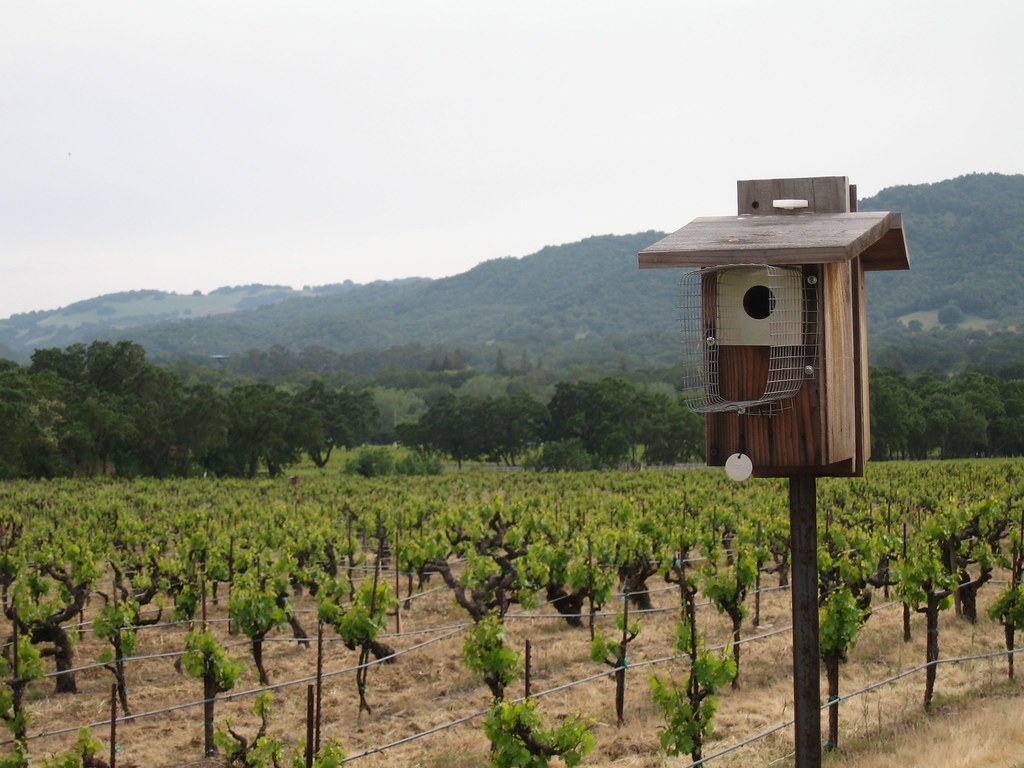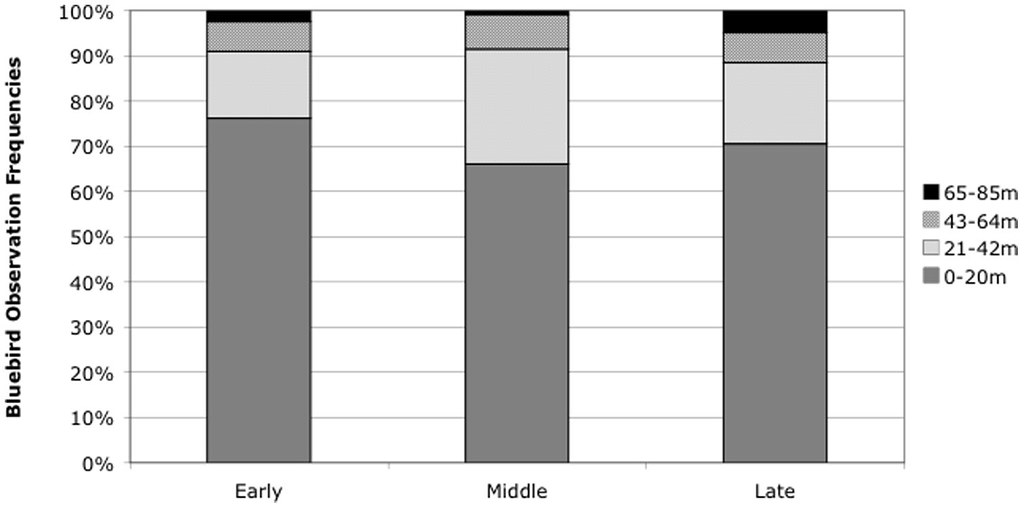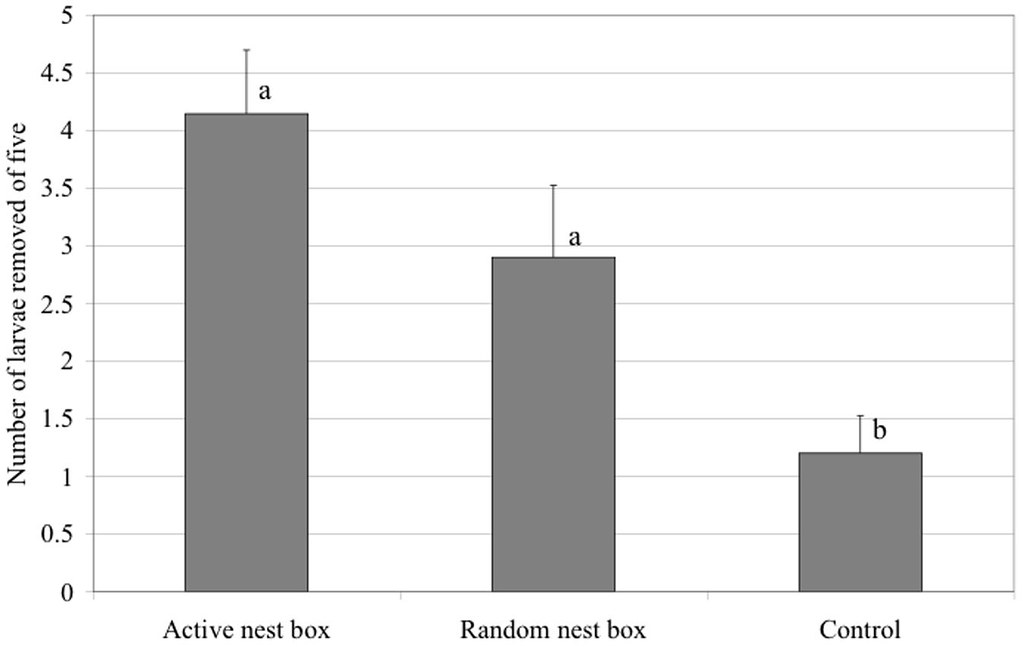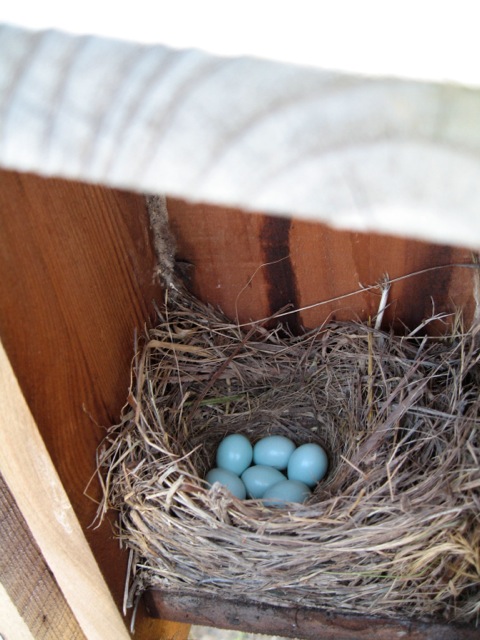Journal Club: Bird-friendly California vineyards may have fewer pests
SUMMARY: Insectivorous cavity-nesting birds can be encouraged to occupy vineyards by giving them nest boxes. New research documents that these birds reciprocate by providing significant eco-friendly pest control services to winegrape growers.
![]() I was in graduate school when I first read Rachel Carson’s classic book, Silent Spring [Amazon UK; Amazon US Affiliate Link]. This poignant commentary on chemical pesticide abuse stunned the public and launched the environmental movement. In her book, Dr Carson presented evidence showing that rampant pesticide abuse was killing birds and destroying the environment — and was also killing humans. It led people to ask: Is it possible to grow sufficient food crops without constantly resorting to pesticides and other heavy-duty poisons?
I was in graduate school when I first read Rachel Carson’s classic book, Silent Spring [Amazon UK; Amazon US Affiliate Link]. This poignant commentary on chemical pesticide abuse stunned the public and launched the environmental movement. In her book, Dr Carson presented evidence showing that rampant pesticide abuse was killing birds and destroying the environment — and was also killing humans. It led people to ask: Is it possible to grow sufficient food crops without constantly resorting to pesticides and other heavy-duty poisons?
Ironically, not applying pesticides to crops whilst simultaneously providing a bird-friendly environment may control insect pest populations. A team of researchers, led by Julie Jedlicka, a NSF Postdoctoral Fellow at University of California Berkeley, designed several experiments to test this.
“Insectivorous birds are often overlooked as sources of pest predation, however, they are likely providing pest control services in many agricultural fields, we just need to look for it”, says Dr Jedlicka. She has studied bird-friendly coffee farms in Chiapas, Mexico.
“Much of what we know about biodiversity in agriculture is from the tropics”, she explains. But can we take what we’ve learned in the tropics and apply it to agriculture in North America?
“I decided for my PhD I wanted to see whether we could create bird-friendly agricultural systems in the temperate zone”, writes Dr Jedlicka in email. “Having moved recently to California, vineyards were a logical choice. I was inspired by grassroots efforts of some winegrape growers who had established songbird nest boxes in their vineyards.”
Realizing that there was great research potential by systematically following up the winegrape growers’ efforts, Dr Jedlicka expanded upon their methods to study the effects of insectivorous birds on winegrape agriculture. In this study, she focused on western bluebirds.
Western bluebirds, Sialia mexicana, are generalist insectivorous thrushes that are found in open coniferous and deciduous forests, wooded riparian areas, semi-open country — and in agricultural areas — throughout the western United States and Mexico.
Western bluebirds nest in cavities. Previous research in California showed that when provided nest boxes, they have higher reproductive success than when relying on natural cavities: the birds start laying eggs earlier, they have lower predation rates, their nestlings have fewer parasites, and more of their chicks fledge (doi:10.1046/j.1526-100X.2002.00129.x).
But because natural nest cavities are a limited resource, competition between bluebirds and other bird species to possess these cavities can be fierce. Additionally, western bluebirds do not tolerate the presence of another pair of bluebirds if their nest is too close: they must be separated by at least 15-30 metres (50-100 feet). Thus, by keeping these bluebird habits in mind, it is easy to control their density by providing nest boxes in suitable agricultural areas.

Bluebird nest box in a California vineyard.
Image: Julie Jedlicka (with permission).
After placing the nest boxes in the vineyard, the team documented where the bluebirds spent most of their time in relation to these boxes. Predictably, they found that the bluebirds were concentrated near their nest boxes early in the season, which is when pairs establish ownership over their chosen nest cavity, construct the nest, lay their eggs and incubate them. As the season progressed, bluebirds were observed at greater distances away from their nests with increasing frequency when bluebird adults were often seen foraging with young birds in small flocks consisting of three to five individuals (figure 1; larger view):

But what impact were all these birds having on insect populations? To answer this question, the team set up sentinel prey studies.
“Sentinel prey studies, which monitor removal rates of immobilized, tethered, or frozen prey in the field are common in the entomology literature for comparing relative predation pressure under different conditions”, the authors explain in their paper.
Dr Jedlicka pinned larvae from a variety of insect species to pieces of cardboard and placed them 5 metres apart between the rows of grapes. All cardboard pieces were in place before 7:00 am. Dr Jedlicka returned approximately six hours later to collect the cardboard pieces and scored the pinned larvae as either present or missing — and likely consumed by predators (figure 2):

As you can see, sentinel insects near active bluebird nest boxes were 3.5 times more likely to disappear than those located randomly throughout the vineyard (controls), indicating a high level of predation by resident bluebirds (figure 2, larger view). Since a previous study found that each pair of bluebirds raising five nestlings requires 124 grams of “bugs” (arthropods) daily (doi:10.1890/1051-0761(2006)016[0696:AEOVPO]2.0.CO;2), this level of efficiency is hardly surprising.

A western bluebird nest containing six eggs.
Image: Julie Jedlicka (with permission).
A bluebird pair produces at least one and often two broods per year in California, and each clutch averages between four and six eggs. Young birds from the first clutch typically remain at the nest to help the parents rear the second brood. So using a little mathematics, we can see that one pair of western bluebirds will quickly becomes a group of 12 hungry birds that consumes 248 grams of insects — a very large number. These would include crop pests although the birds are probably also consuming neutral insects as well as arthropod predators of crop pests.
In this study, not only were the sites with nest boxes better protected from potential pest infestations, but even more important, there was no evidence that other bird species that may eat grapes were attracted to the nest boxes. Most birds that are considered “grape predators” don’t nest in cavities (nor in nest boxes).
“I think it is important for the public to know that agricultural systems can provide habitat for wildlife”, explains Dr Jedlicka in email. “There are ways to design and structure [agricultural areas] so they are highly productive and beneficial for wildlife.”
Providing nest boxes to bluebirds is a low-maintenance, low-cost and ecologically-friendly way to benefit from the significant “ecosystem services” that these birds provide by simply being alive. Further, these methods are regionally adaptable.
“Great tits (Parus major) are cavity nesting species that respond well to nest boxes in agricultural lands” in Europe, explains Dr Jedlicka in email. “They were found to reduce caterpillar damage in apple orchards in the Netherlands (Mols and Visser 2002; doi:10.1046/j.1365-2664.2002.00761.x).” Mols and Visser later expanded their first study to commercial orchards and found similar effects [doi:10.1371/journal.pone.0000202].
The question now remains whether vineyards themselves are providing enough food for bluebird populations. Perhaps the bluebirds are relying on uncultivated natural patches in the vineyards to find food instead of only preying on insects in the grapes?
“I am trying to systematically analyze what role bluebirds are playing as predators in vineyards”, replies Dr Jedlicka. “My future work is analyzing what adult and nestling bluebirds have been eating by analyzing prey [DNA] from [the birds’] fecal matter.”
Knowing precisely which arthropods are being consumed by generalist insectivores, and in what quantities, is still not known.
“It has been a black hole in the community ecology literature for a long time because prey items are so small and birds are so highly mobile. We are just beginning to gain the tools we need to answer these questions.”
Note: this piece is mirrored from here.
Sources:
Julie A. Jedlicka, Russell Greenberg, & Deborah K. Letourneau (2011). Avian Conservation Practices Strengthen Ecosystem Services in California Vineyards. PLoS ONE, 6(11):e27347 doi:10.1371/journal.pone.002734
Julie Jedlicka [emails; 8 & 9 November 2011]
Other studies cited:
Mols, C., & Visser, M. (2002). Great tits can reduce caterpillar damage in apple orchards. Journal of Applied Ecology, 39 (6), 888-899 doi:10.1046/j.1365-2664.2002.00761.x
Mols, C., & Visser, M. (2007). Great Tits (Parus major) Reduce Caterpillar Damage in Commercial Apple Orchards. PLoS ONE, 2 (2) doi:10.1371/journal.pone.0000202
Germaine, Heather L. and Stephen S. Germaine (2002). Forest Restoration Treatment Effects on the Nesting Success of Western Bluebirds (Sialia mexicana). Restoration Ecology, 10 (2), 362-367 doi:10.1046/j.1526-100X.2002.00129.x
.. .. .. .. .. .. .. .. .. .. .. ..
twitter: @GrrlScientist
facebook: grrlscientist
email: grrlscientist@gmail.com

Very interesting! TFS
Great post and what a beautiful bird. I love the bluebirds.
What about all of the vineyards that are being covered in netting? Does the netting entangle birds? Does anyone really know the answer to this? Is it monitored? More and more vineyards, and even some orchards, are covering the plants with netting.
actually, i don’t know. it’s likely that some birds become entangled, but how many and to what end, i cannot say.
What about all of the vineyards that are being covered in netting? Does the netting entangle birds? Does anyone really know the answer to this? Is it monitored? More and more vineyards, and even some orchards, are covering the plants with netting.
What about all of the vineyards that are being covered in netting? Does the netting entangle birds? Does anyone really know the answer to this? Is it monitored? More and more vineyards, and even some orchards, are covering the plants with netting.